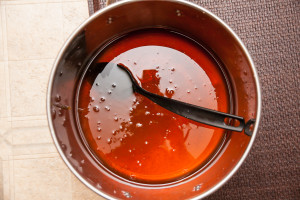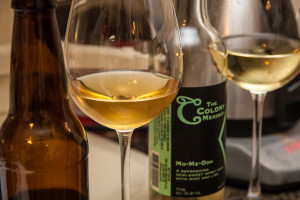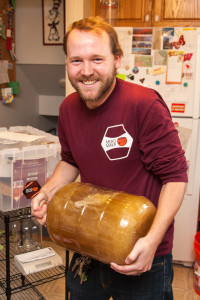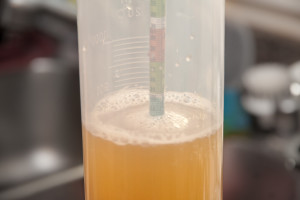 In Episode 004, we put into action everything we’ve brought up in our first three episodes (001, 002a, 002b, 003) and make a mead live for you during the recording. We take you through the steps to making your first mead batch. In our case, we are making a sweet traditional mead, but you can vary the honey content to make your mead on the drier if you’d like.
In Episode 004, we put into action everything we’ve brought up in our first three episodes (001, 002a, 002b, 003) and make a mead live for you during the recording. We take you through the steps to making your first mead batch. In our case, we are making a sweet traditional mead, but you can vary the honey content to make your mead on the drier if you’d like.
Right click here to download the mp3 directly.
Drinks in This Episode

Allen: The Colony Meadery‘s Mo-Me-Doh
Tysen: Tysen’s Cin & Spicy (Ceylon cinnamon and hot peppers, finished sweet)
The Recipe
10.4 lbs Wisconsin Wildflower Honey (from Gentle Breeze Honey)
3 tsp Yeast Nutrient (LD Carlson Yeast Nutrient)
1.5 tsp Yeast Energizer (LD Carlson Yeast Energizer)
1 packet (5 grams) Lalvin ICV D47
Spring water to 3 gallons
OG: 1.122 (28.4% Brix)
The Process
Pour honey into large brewpot. Add one gallon spring water. Mix vigorously, both dissolving the honey and aerating the must. We use a long-handled spoon, but a drill stirrer may speed up the process for you.
Add nutrients to the must according to this schedule:
- 1/2 total nutrient and energizer quantity at pitching of yeast
- 1/4 total nutrient and energizer quantity 24 hours into fermentation
- 1/4 total nutrient and energizer quantity 48 hours into fermentation
In our case, we add 1.5 tsp Yeast Nutrient and 0.75 tsp Yeast Energizer when mixing our must. This is half of the total additions per the recipe outline above.
Rehydrate yeast per the packet instructions (pour into 104 to 109 deg F water, after 15 minutes mix up and add to fermenter). We use 1 packet for 3 gallons. If you are making a larger batch, consider adding a second packet (doubling to 10 grams) for better fermentation.

Pour must, nutrients, and yeast into the fermenter. Fill to 3 gallons. Take a specific gravity measurement using your hydrometer. Ours came out to 1.122, with a refractometer reading of 28.4% Brix.
Put an airlock on your fermenter. For the first few days, you can leave this dry to start as the must will be pushing out so much carbon dioxide that you don’t need to worry much about oxidation (and oxygen is good for mead at this point of the ferment anyway).

After about one month or when fermentation activity has finished, rack to a new carboy to get the mead off of the lees. After another few months, when the mead is satisfactory to your taste, bottle and serve. We hope you enjoy it!
Links in This Episode
- American Homebrewers Association explains Staggered Nutrient Additions
- Beer and Wine Journal speaks to Staggered Nutrient Additions
- Mead Made Right showcases a Total Organic Staggered Nutrient Addition (TOSNA) protocol using only Fermaid O and Go Ferm (We’ll have to test this later!)
- Ceylon Cinnamon vs Cassia Cinnamon
- Margerite Reid Memorial Highland Dance Workshop held annually in King of Prussia, PA (the reason I made it up to The Colony Meadery)
Excellent post. I will be dealing with many of thedse issues as well..